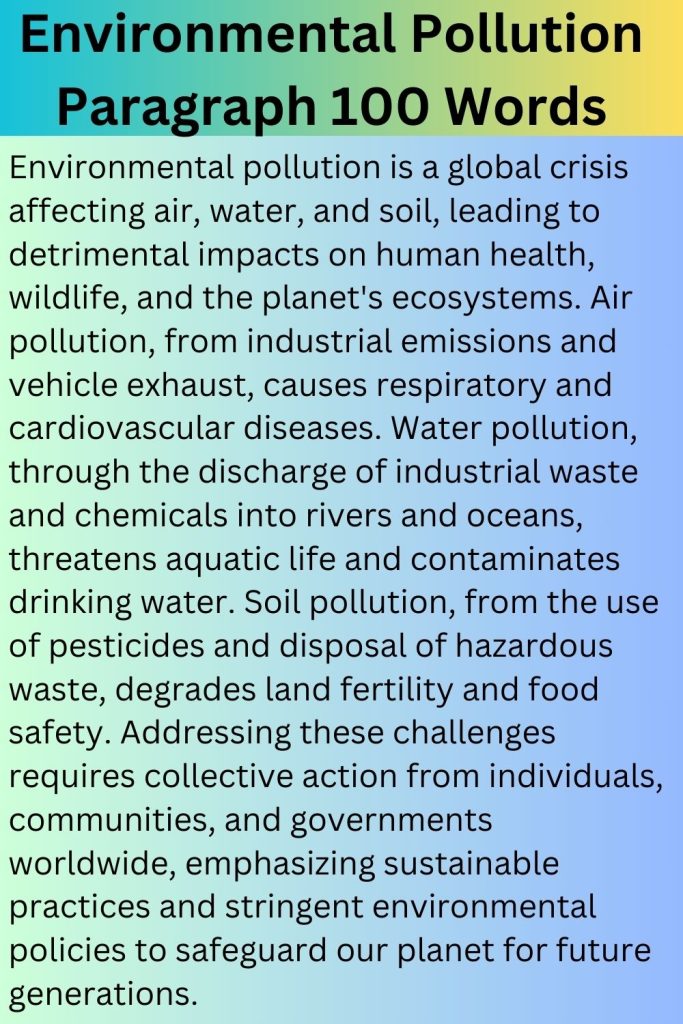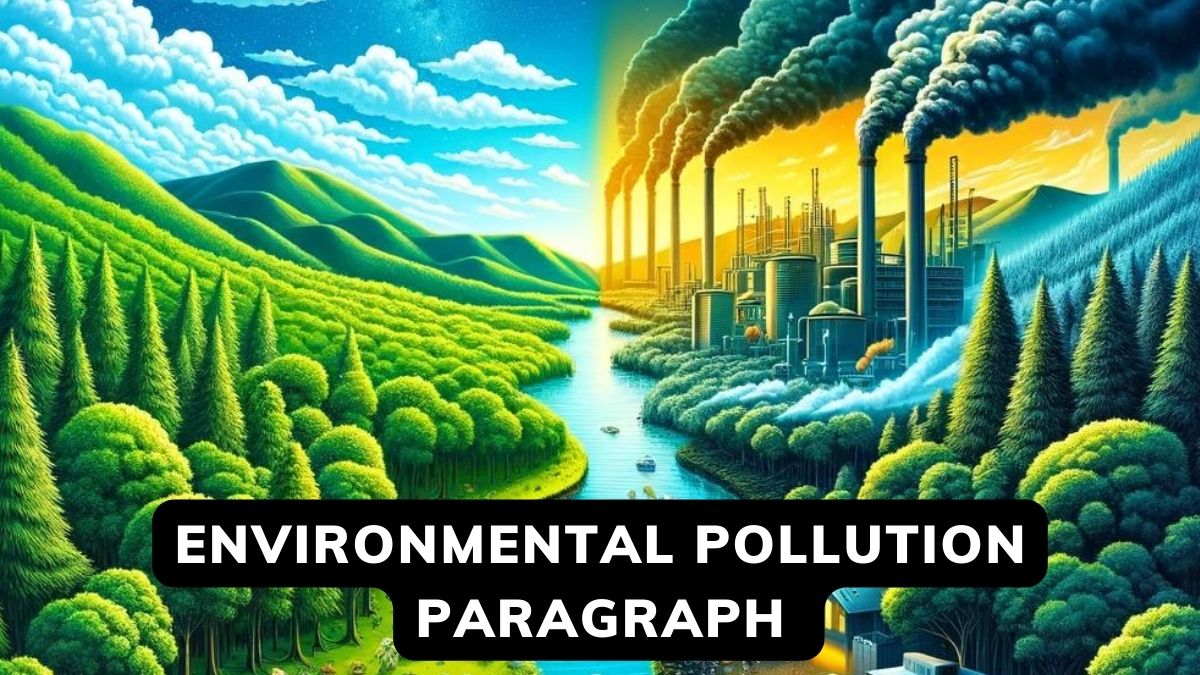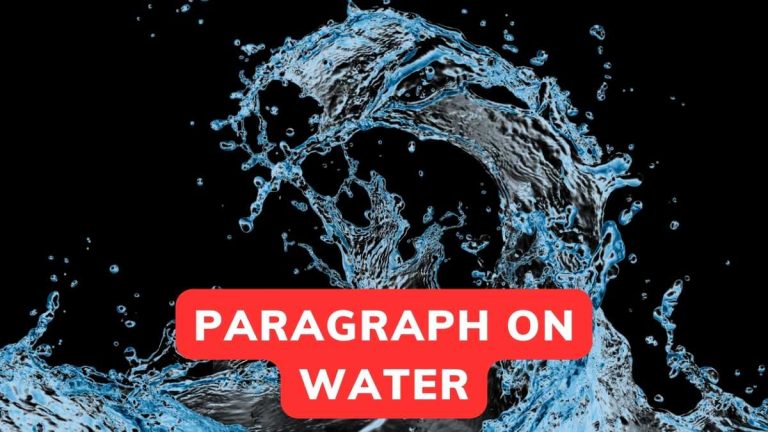Environmental Pollution Paragraph 100,-300 Words And Class 7-10
In an age where the health of our planet is more crucial than ever, the issue of environmental pollution takes center stage, demanding immediate and comprehensive action. This omnipresent threat, stemming from human activities, not only endangers our own health but also the very ecosystems we rely on. By exploring the depths of environmental pollution through various lenses—ranging from concise 100-word overviews suitable for younger students to detailed 300-word discussions for older learners—we embark on a critical journey towards understanding and action.
Navigating through this exploration, we’ll delve into the significance of educating different age groups, from class 6 to 10, about the multifaceted impacts of pollution. Each tailored paragraph serves as a stepping stone, building a foundation of awareness and empowerment for the younger generation. As we transition from the basics to more complex insights, this journey not only enlightens but also equips our future stewards of the planet with the knowledge they need to make a difference.
Environmental Pollution Paragraph 100 Words
Environmental pollution is a global crisis affecting air, water, and soil, leading to detrimental impacts on human health, wildlife, and the planet’s ecosystems. Air pollution, from industrial emissions and vehicle exhaust, causes respiratory and cardiovascular diseases. Water pollution, through the discharge of industrial waste and chemicals into rivers and oceans, threatens aquatic life and contaminates drinking water. Soil pollution, from the use of pesticides and disposal of hazardous waste, degrades land fertility and food safety. Addressing these challenges requires collective action from individuals, communities, and governments worldwide, emphasizing sustainable practices and stringent environmental policies to safeguard our planet for future generations.

Environmental Pollution Paragraph 150 Words
Environmental pollution stands as one of the most significant challenges faced by humanity today, manifesting in various forms such as air, water, and soil pollution, each carrying profound consequences for health, biodiversity, and the climate. Industrial emissions, vehicular exhaust, and the burning of fossil fuels release harmful pollutants into the air, leading to serious respiratory and cardiovascular conditions among humans, while also contributing to the broader phenomenon of climate change. Water bodies, vital to all forms of life, become contaminated with chemicals, waste, and plastics, resulting in devastated aquatic ecosystems and unsafe drinking water. Soil pollution, through excessive use of pesticides and disposal of industrial waste, compromises agricultural productivity and food safety, affecting human health and economic well-being. This multi-faceted crisis demands an urgent and cohesive response, including the adoption of green technologies, enforcement of strict environmental regulations, and a collective shift towards more sustainable lifestyles to mitigate the impacts of pollution on our planet.
Environmental Pollution Paragraph 200 Words
Environmental pollution, a dire consequence of human activity, has escalated into a critical issue that demands immediate global attention. Characterized by the contamination of air, water, and soil, it poses severe risks to human health, endangers wildlife, and disrupts the delicate balance of ecosystems. Air pollution, resulting from the emission of harmful gases and particulates from industrial processes, vehicles, and the burning of fossil fuels, is linked to respiratory disorders, cardiovascular diseases, and an increased mortality rate. Water pollution, on the other hand, stems from the discharge of industrial effluents, agricultural runoff, and untreated sewage into water bodies, leading to the degradation of aquatic habitats, Soil pollution, caused by the use of chemical fertilizers and pesticides, waste dumping, and industrial discharge, diminishes soil fertility, contaminates food crops, and poses serious health risks through bioaccumulation. Furthermore, pollution exacerbates climate change, contributing to extreme weather conditions, rising sea levels, and loss of biodiversity. To combat this global crisis, it is imperative to implement stringent environmental regulations, promote sustainable practices, and foster international cooperation to ensure the preservation and restoration of the natural environment for future generations.
Environmental Pollution Paragraph 250 Words
Environmental pollution, an alarming global crisis, results from the discharge of pollutants into the earth’s natural resources, leading to catastrophic consequences for human health, biodiversity, and the planet’s climate. This multifaceted issue encompasses air, water, and soil pollution, each with its distinct sources and devastating impacts. Air pollution is primarily caused by industrial emissions, vehicular exhaust, and the burning of fossil fuels, releasing a myriad of harmful pollutants into the atmosphere. These pollutants, including particulate matter, nitrogen oxides, and sulfur dioxide, contribute to respiratory ailments, cardiovascular diseases, and premature deaths, besides playing a significant role in global warming and climate change. Water pollution, stemming from industrial waste, agricultural runoff, and sewage discharge, contaminates rivers, lakes, and oceans, endangering aquatic life and making water unsafe for consumption and recreational purposes. Soil pollution, caused by chemical pesticides, heavy metals, and landfill waste, compromises soil health, reduces agricultural productivity, and poses severe risks to food safety and human health. The indirect effects of pollution are equally grave, leading to ecosystem imbalances, loss of biodiversity, and exacerbation of climate change. Addressing this critical issue requires a holistic approach, involving stringent environmental legislation, sustainable industrial practices, public awareness campaigns, and global cooperation to reduce pollution levels. Emphasizing renewable energy sources, recycling, and conservation efforts are crucial steps towards mitigating the adverse effects of pollution and safeguarding the environment for future generations.
Environmental Pollution Paragraph 300 Words
Environmental pollution, the pervasive introduction of contaminants into the natural environment, has emerged as one of the gravest threats to global health, ecological balance, and climate stability. This complex crisis is characterized by the degradation of air, water, and soil, each afflicted by different pollutants emanating from a wide array of human activities. Air pollution, marked by the release of gases like carbon monoxide, sulfur dioxide, and nitrogen oxides, along with particulate matter from industrial emissions, vehicle exhausts, and the burning of fossil fuels, poses severe risks to human health, including respiratory and cardiovascular diseases, and contributes significantly to the phenomenon of global warming. Water pollution, caused by the discharge of industrial effluents, agricultural chemicals, and untreated sewage into water bodies, not only devastates aquatic ecosystems but also compromises the quality of drinking water, leading to numerous health hazards. Soil pollution, resulting from the indiscriminate disposal of hazardous waste, excessive use of chemical fertilizers and pesticides, and industrial activities, undermines soil fertility, affects food security, and introduces toxic substances into the food chain.
The ripple effects of environmental pollution are profound, influencing climate patterns, accelerating biodiversity loss, and contributing to the intensification of natural disasters. Its global scope necessitates immediate and concerted efforts from international bodies, national governments, industries, and communities to adopt and implement comprehensive strategies aimed at pollution reduction. This includes advancing cleaner technologies, enforcing stringent environmental regulations, promoting sustainable agricultural and industrial practices, and raising public awareness about the importance of environmental stewardship. Ultimately, safeguarding the environment from pollution is not just a duty of the present generation but a legacy for the future, ensuring the health and well-being of both the planet and its inhabitants.
Environmental Pollution Paragraph For Class 7
Environmental pollution is a serious issue that affects our planet in many harmful ways. It refers to the contamination of our surroundings due to various pollutants that come from different sources, including factories, vehicles, agriculture, and waste disposal. These pollutants can be chemicals, plastics, or even noise, harming air, water, and soil. For instance, factories release toxic gases into the air, vehicles produce carbon monoxide that pollutes the air we breathe, and waste materials can contaminate our water sources. This pollution affects not only the environment but also our health, leading to respiratory problems, waterborne diseases, and other health issues. It’s crucial for us, especially as young students, to understand the importance of protecting our environment. We can contribute by reducing waste, recycling more, and using less plastic. Every small action towards a cleaner environment helps in making our planet a better place to live for us and future generations.
Environmental Pollution Paragraph For Class 9
Environmental pollution is a growing concern that impacts our planet’s ecosystems, health, and climate. It occurs when harmful substances, such as chemicals and waste, are introduced into the natural environment, leading to detrimental effects on land, water, and air. Major forms of pollution include air pollution, caused by industrial emissions and vehicle exhausts releasing toxic gases and particulate matter into the atmosphere; water pollution, resulting from the discharge of industrial waste and agricultural chemicals into water bodies, harming aquatic life and contaminating drinking water; and soil pollution, which involves the contamination of land through hazardous chemicals and waste disposal, affecting plant life and food safety. Additionally, noise pollution from urban development and industrial activities disrupts wildlife habitats and affects human health. The consequences of environmental pollution are far-reaching, contributing to climate change, health issues in humans, and the loss of biodiversity. Addressing this critical issue requires collective efforts from governments, industries, and individuals to adopt sustainable practices, enforce strict environmental regulations, and raise awareness about the importance of preserving our natural resources for future generations.
Environmental Pollution Paragraph For Class 10
Environmental pollution has emerged as one of the most pressing challenges of our time, posing a significant threat to the health of our planet and its inhabitants. It encompasses the contamination of our natural surroundings through the introduction of harmful substances and activities that disrupt the balance of ecosystems. This includes air pollution, where pollutants like particulate matter and toxic gases from industrial activities and vehicular emissions degrade the quality of the air we breathe, leading to respiratory and cardiovascular diseases among humans and wildlife. Water pollution, another critical aspect, occurs when chemicals, waste, and other pollutants are dumped into water bodies, severely affecting aquatic life, contaminating water sources, and posing health risks to all forms of life. Soil pollution, caused by the use of pesticides, industrial waste disposal, and other harmful chemicals, affects the fertility of the soil, compromising food safety and agricultural productivity.
The consequences of environmental pollution are dire, contributing to global warming, climate change, and a decline in biodiversity, impacting the natural balance and sustainability of ecosystems. For our part, we must take immediate action to mitigate these effects. This includes adopting sustainable practices such as recycling, reducing waste, using renewable energy sources, and supporting policies and initiatives aimed at environmental protection. Educating ourselves and others about the importance of preserving our environment is also crucial. As we move forward, it is imperative for everyone, including governments, industries, and individuals, to work together in harmony to tackle environmental pollution, ensuring a healthier planet for future generations.
Environmental Pollution Paragraph SSC
Environmental pollution, increasingly recognized as one of the most pressing issues of our time, poses a serious threat to the health of our planet and its inhabitants. It refers to the contamination of the earth’s natural resources by harmful substances and activities, leading to detrimental effects on air, water, and soil. Air pollution, caused by the emission of toxic gases and particulates from industrial processes, vehicles, and the burning of fossil fuels, significantly impacts human health, leading to respiratory and cardiovascular diseases, and contributes to the global crisis of climate change. Water pollution, resulting from the discharge of industrial waste, agricultural runoff, and sewage into water bodies, not only destroys aquatic ecosystems but also affects the quality of drinking water, posing severe health risks to humans and animals alike. Soil pollution, caused by the improper disposal of hazardous waste and excessive use of chemical fertilizers and pesticides, degrades land fertility, contaminating food crops and affecting food security. The consequences of environmental pollution are far-reaching, affecting not just human health but also leading to the loss of biodiversity, alteration of ecosystems, and contributing to extreme weather patterns and rising global temperatures. Addressing this critical issue requires a concerted effort from governments, industries, and individuals worldwide. Implementing stricter environmental regulations, investing in renewable energy sources, promoting sustainable agricultural and industrial practices, and raising public awareness about the importance of preserving our natural environment are essential steps towards mitigating the effects of pollution and safeguarding our planet for future generations.
Environmental Pollution Paragraph
Environmental pollution is a serious issue that affects our planet in many harmful ways. It refers to the contamination of our surroundings due to various pollutants that come from different sources, including factories, vehicles, agriculture, and waste disposal. These pollutants can be chemicals, plastics, or even noise, harming air, water, and soil. For instance, factories release toxic gases into the air, vehicles produce carbon monoxide that pollutes the air we breathe, and waste materials can contaminate our water sources. This pollution affects not only the environment but also our health, leading to respiratory problems, waterborne diseases, and other health issues. It’s crucial for us, especially as young students, to understand the importance of protecting our environment. We can contribute by reducing waste, recycling more, and using less plastic. Every small action towards a cleaner environment helps in making our planet a better place to live for us and future generations.







